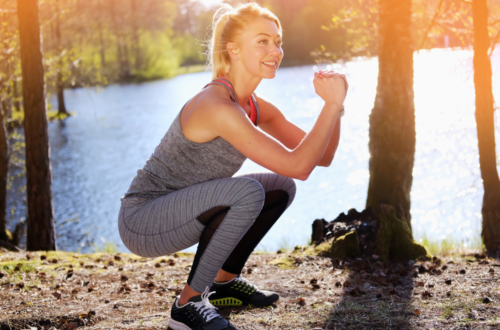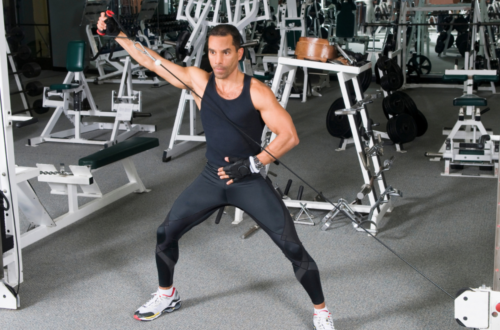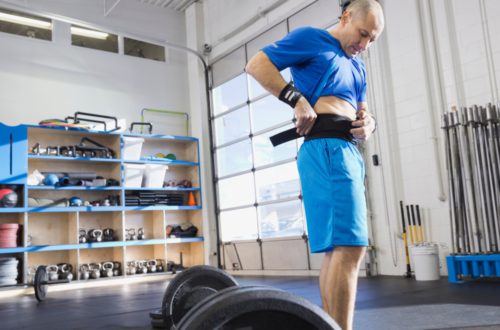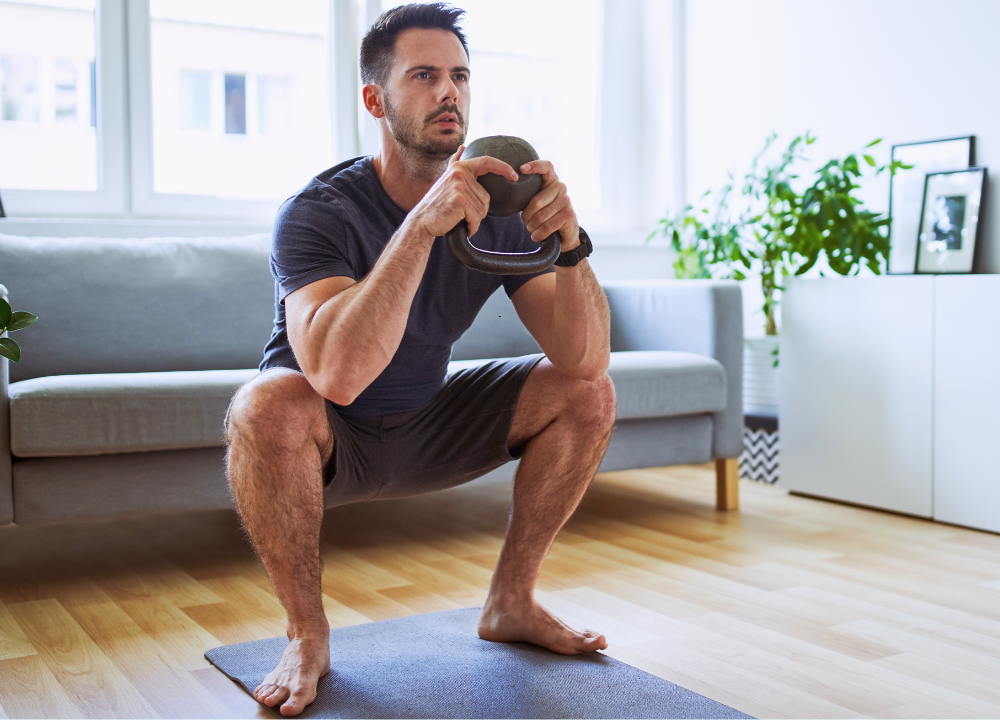
Goblet Squats for Glutes: How to Perform Them & Muscles Worked
Goblet squats are not only effective for glute development but also improve core strength and stability. This exercise is suitable for all fitness levels and can be easily incorporated into any workout routine. Consistent practice will lead to noticeable improvements in lower body strength and muscle definition.
Table of Contents
How To Master Goblet Squats In 3 Steps
Mastering goblet squats can take your lower body workout to the next level. Follow these three steps to perfect your form and maximize your gains.
Step 1: Proper Setup And Stance
Setting up correctly is crucial for effective goblet squats. Here’s how to do it:
- Grab a Dumbbell: Hold a dumbbell vertically with both hands under the top weight.
- Feet Position: Place your feet shoulder-width apart. Toes should point slightly outward.
- Chest Up: Keep your chest up and your shoulders back. This helps maintain a straight back.
- Core Engaged: Tighten your core muscles to stabilize your spine.
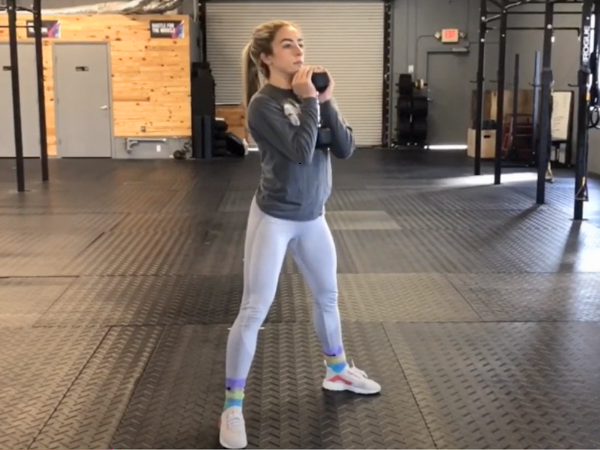
Step 2: Controlled Descent And Squat Depth
The descent phase is where you build strength and stability. Focus on these points:
- Slow Movement: Lower yourself slowly to maintain control.
- Knees Out: Push your knees outward to avoid collapsing inward.
- Back Straight: Keep your back straight to prevent injury.
- Depth: Aim to squat down until your thighs are parallel to the ground.
Here’s a quick checklist for your descent:
- Lower slowly
- Push knees outward
- Maintain a straight back
- Squat until thighs are parallel
Step 3: Drive Up With Power And Stability
The ascent is crucial for engaging your glutes and other muscles. Follow these tips:
- Push Through Heels: Drive up through your heels to activate your glutes.
- Explosive Movement: Rise quickly but maintain control.
- Chest Up: Keep your chest up as you ascend to avoid leaning forward.
- Core Tight: Keep your core engaged for stability.

Best Goblet Squat Modifications For All Fitness Levels
Here, we’ll explore the best goblet squat modifications for beginners, advanced athletes, and those focusing on mobility. These modifications ensure everyone gets the most out of this powerful movement.
Modification For Beginners: Squat To A Box
For beginners, squatting to a box provides the perfect starting point. This modification ensures proper form and builds confidence. Here’s how to perform it:
- Hold a dumbbell vertically in front of your chest.
- Stand in front of a box or bench.
- With feet shoulder-width apart, lower your body by bending your knees.
- Keep lowering until your glutes touch the box lightly.
- Push through your heels to return to the starting position.
This method helps maintain balance and prevents excessive forward lean. It also ensures that beginners do not squat too low, which can be challenging initially.
Benefits for Beginners:
- Improves balance and coordination.
- Teaches proper depth and form.
- Reduces risk of injury.
Advanced Modification: Goblet Squat With Pulse Reps
For those ready to take their goblet squats to the next level, goblet squat with pulse reps is an excellent choice. This modification increases time under tension, enhancing muscle growth and endurance. Follow these steps:
- Hold a dumbbell in front of your chest.
- Perform a standard goblet squat.
- When you reach the bottom position, pulse up and down slightly.
- Complete 3-5 small pulses before standing back up.
Why Pulse Reps Work:
- Increase time under tension.
- Enhance muscle endurance.
- Target glutes and quads more effectively.
Advanced athletes can incorporate pulse reps into their routine to break through plateaus and add variety to their workouts.
Mobility-focused Modification: Goblet Squat With A Heel Lift
For those aiming to improve mobility, goblet squat with a heel lift is ideal. This modification helps those with limited ankle mobility to achieve a deeper squat. Here’s how to do it:
- Place a small plate or wedge under your heels.
- Hold a dumbbell in front of your chest.
- Perform a standard goblet squat.
- Focus on maintaining an upright torso.
This modification allows for a deeper squat by compensating for limited ankle flexibility. It also helps in maintaining proper form and reducing strain on the lower back.
Benefits for Mobility:
- Improves squat depth.
- Enhances ankle flexibility.
- Reduces lower back strain.
Incorporating this modification can help improve overall squat mechanics and flexibility over time.
I recommend reading the article: 19 Alternatives to Squats for Home and Gym Workouts.
How To Do Goblet Squats With Spot-on Form
In this guide, we’ll delve into how to do goblet squats with spot-on form to ensure you get the most out of this fantastic movement.
Key Points For Perfect Goblet Squat Form
To achieve the best results and avoid injuries, follow these key points:
- Hold the Dumbbell Properly: Grasp a dumbbell vertically by one end, holding it close to your chest.
- Feet Position: Stand with feet shoulder-width apart and toes slightly turned out.
- Engage Your Core: Keep your core tight throughout the movement to support your spine.
- Initiate the Squat: Begin the squat by pushing your hips back as if sitting on a chair.
- Knees and Toes Alignment: Ensure your knees track over your toes to prevent joint strain.
- Depth: Lower yourself until your thighs are at least parallel to the ground.
- Push Through Heels: Drive through your heels to return to the starting position.
Common Form Mistakes And How To Avoid Them
Avoid these common mistakes to keep your form flawless:
- Rounding the Back: Keep your chest up and back straight to avoid spinal injuries.
- Knees Caving In: Focus on pushing your knees outward to maintain alignment.
- Not Squatting Deep Enough: Aim for thighs parallel to the floor for optimal muscle activation.
- Heels Lifting Off the Ground: Ensure your heels stay grounded to maintain balance and power.
To help you avoid these mistakes, use a mirror or record yourself to check your form. Practicing in front of a mirror allows you to make real-time adjustments. Also, consider working with a fitness coach for personalized guidance.
Tips To Maintain Form As You Increase Weight
Maintaining form becomes challenging as you increase weight. Follow these tips:
- Progress Gradually: Increase weight in small increments to give your body time to adapt.
- Focus on Form First: Prioritize perfecting your form before adding more weight.
- Use Proper Breathing: Exhale as you push up and inhale as you lower down.
- Incorporate Mobility Work: Regularly stretch and foam roll to maintain flexibility and prevent stiffness.
- Rest Adequately: Ensure you get enough rest between workouts to allow muscle recovery.
Consider using a lifting belt for additional support as you lift heavier weights. Maintaining a strong core and proper breathing techniques are crucial to handle increased loads safely.
Leaning Forward During Squat: How To Fix Your Form
Let’s explore how to fix your form and ensure you get the most out of your goblet squats.
Strengthening Core And Back Muscles To Prevent Leaning
Leaning forward during goblet squats often happens due to weak core and back muscles. These muscles play a crucial role in maintaining proper posture.
Here are some exercises to strengthen these muscles:
- Planks: Hold a plank position for 30 seconds to 1 minute. This exercise engages your core muscles, helping them become stronger.
- Bird-Dogs: Get on all fours, extend one arm and the opposite leg. Hold for a few seconds, then switch sides. This exercise strengthens both your core and back.
- Supermans: Lie face down, lift your arms and legs off the ground simultaneously. Hold for a few seconds, then lower them. This targets your lower back muscles.
Incorporate these exercises into your routine three times a week:
| Exercise | Reps | Sets |
|---|---|---|
| Planks | 30-60 seconds | 3 |
| Bird-Dogs | 10 per side | 3 |
| Supermans | 15 | 3 |
Proper Foot Positioning To Maintain Balance
Proper foot positioning is key to maintaining balance during goblet squats. Incorrect foot placement can cause forward leaning.
Follow these steps to ensure correct foot positioning:
- Stand with feet shoulder-width apart: This provides a stable base for the squat.
- Point toes slightly outward: A slight outward angle helps you maintain balance and allows for a deeper squat.
- Keep weight on your heels: Ensure your weight is distributed on your heels rather than the balls of your feet.
Common mistakes and how to avoid them:
- Feet too close together: This reduces stability. Ensure your feet are shoulder-width apart.
- Toes pointing straight forward: Angle your toes slightly outward for better balance.
- Weight on toes: Focus on keeping your weight on your heels to prevent leaning forward.
How To Use Cues And Mirrors To Correct Forward Lean
Cues and mirrors are great tools for correcting forward lean during goblet squats. They help you monitor and adjust your form in real-time.
Using cues:
- “Chest up”: Remind yourself to keep your chest up throughout the squat.
- “Sit back”: Imagine sitting back into a chair to prevent your knees from moving too far forward.
- “Engage core”: Keep your core tight to support your back and maintain an upright position.
Using mirrors:
- Position a mirror in front: Watch yourself to ensure your chest stays up and back remains straight.
- Side mirror: Place a mirror to the side to monitor your form from a different angle.
- Check alignment: Use the mirror to check that your knees, hips, and shoulders are aligned.
By using these tips and tools, you can correct your form and get the most out of your goblet squats.
What Muscles Do Goblet Squats Work?
Understanding what muscles Goblet Squats work can help you maximize your workout routine and achieve better results.
Primary Muscles Targeted By Goblet Squats
Goblet Squats mainly target the quadriceps and glutes. These muscles are crucial for lower body strength and stability. When you perform a Goblet Squat, you hold a weight close to your chest. This position forces your body to engage the quads and glutes to maintain balance and control.
Key primary muscles worked include:
- Quadriceps: Located at the front of your thighs, these muscles are heavily engaged during the squatting movement.
- Gluteus Maximus: The largest muscle in the glutes, responsible for hip extension and giving your backside its shape.
Here is a table summarizing the primary muscles:
| Muscle | Location | Function |
|---|---|---|
| Quadriceps | Front of Thighs | Knee Extension |
| Gluteus Maximus | Buttocks | Hip Extension |
Secondary Muscles Activated During The Movement
While Goblet Squats primarily target the quads and glutes, they also activate several secondary muscles. These muscles help in maintaining form and stability throughout the movement.
Key secondary muscles include:
- Hamstrings: Located at the back of your thighs, these muscles assist in hip extension.
- Adductors: Inner thigh muscles that help in stabilizing the legs during the squat.
- Core Muscles: These muscles, including the abs and obliques, work to stabilize the torso.
- Calves: Located at the back of the lower leg, they assist in maintaining balance.
Here’s a table summarizing the secondary muscles:
| Muscle | Location | Function |
|---|---|---|
| Hamstrings | Back of Thighs | Hip Extension |
| Adductors | Inner Thighs | Leg Stabilization |
| Core Muscles | Torso | Stabilization |
| Calves | Back of Lower Leg | Balance |
How Goblet Squats Benefit Overall Muscle Development
Goblet Squats offer numerous benefits for overall muscle development. This exercise is not just limited to building the lower body but also contributes to full-body strength and stability.
Here are some key benefits:
- Enhanced Lower Body Strength: By targeting the quads and glutes, Goblet Squats help in building a solid foundation of lower body strength.
- Improved Core Stability: Holding the weight close to your chest forces your core muscles to engage, leading to better stability and posture.
- Better Balance: Activating multiple muscle groups helps in improving overall balance and coordination.
- Functional Fitness: The movement pattern of Goblet Squats mimics everyday activities, making it a functional exercise that enhances daily performance.
In summary, Goblet Squats are a powerful exercise that contributes to overall muscle development. They help in building strength, improving stability, and enhancing functional fitness, making them a valuable addition to any workout routine.
5 Powerful Benefits Of Goblet Squats You Should Know
In this section, we will explore the 5 powerful benefits of goblet squats you should know. From improving lower body strength to enhancing core stability, goblet squats are a must-add to your workout routine.
Benefit 1: Improved Lower Body Strength
Goblet squats are excellent for building lower body strength. They primarily target the quadriceps, hamstrings, and glutes, making them ideal for anyone looking to strengthen their legs.
Here are the main muscles worked during goblet squats:
- Quadriceps
- Hamstrings
- Glutes
- Calves
By regularly performing goblet squats, you can expect to see significant improvements in your leg strength. This will help in daily activities like walking, running, and climbing stairs.
For athletes, stronger legs can enhance performance in sports that require quick movements and powerful leg drive. Adding goblet squats to your routine can give you that extra edge.
Benefit 2: Enhanced Core Stability
Goblet squats don’t just work the legs; they also provide an excellent workout for your core. Holding the weight in front of your chest engages your abdominal muscles, helping to enhance core stability.
Core stability is crucial for maintaining proper posture and balance. A strong core can also prevent injuries by providing better support for your spine.
Benefits of enhanced core stability include:
- Improved balance
- Better posture
- Reduced risk of back pain
Incorporating goblet squats into your routine can lead to a stronger, more stable core, which is essential for overall fitness and health.
Benefit 3: Better Flexibility And Mobility
Goblet squats can significantly improve flexibility and mobility. The movement requires a full range of motion in the hips, knees, and ankles.
Improved flexibility and mobility can make daily tasks easier and reduce the risk of injuries. It also helps in performing other exercises more effectively.
| Body Part | Improvement |
|---|---|
| Hips | Increased range of motion |
| Knees | Better flexibility |
| Ankles | Enhanced mobility |
Regularly performing goblet squats can help keep your joints flexible and mobile, making you more agile and less prone to injury.
Benefit 4: Full-body Conditioning
Goblet squats provide excellent full-body conditioning. While the primary focus is on the lower body, the exercise also engages the upper body and core.
Benefits of full-body conditioning include:
- Improved cardiovascular health
- Increased muscle endurance
- Better overall fitness
Incorporating goblet squats into your workout can help improve your endurance and cardiovascular health, making you fitter and healthier overall.
Benefit 5: Joint Health And Injury Prevention
Goblet squats are excellent for joint health and injury prevention. The controlled movement helps to strengthen the muscles around your joints, providing better support and stability.
Stronger muscles around the joints can reduce the risk of injuries, making goblet squats a safe and effective exercise for people of all fitness levels.
Key benefits for joint health include:
- Stronger joints
- Reduced risk of injuries
- Better support for daily activities
Adding goblet squats to your fitness routine can help maintain healthy joints and prevent injuries, making them a valuable exercise for long-term health and fitness.


